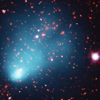CXC Home | Search | Help | Image Use Policy | Latest Images | Privacy | Accessibility | Glossary | Q&A
Tour of El Gordo
Quicktime MPEG
Astronomers using the Chandra X-ray Observatory and ground-based optical telescopes have discovered an extraordinary galaxy cluster some 7 billion light years from Earth. This cluster has been nicknamed "El Gordo," which means the "big" or "fat" one in Spanish. The nickname is a nod to the telescope in Chile that was used to help discover it, but also to the fact that El Gordo is the most massive, the hottest, and gives off more X-rays than any other galaxy cluster at this distance or beyond. The X-rays from Chandra and optical data from the VLT show that El Gordo is, in fact, the collision of two galaxy clusters ramming into one another at millions of miles per hour. This makes a younger cousin to the well-known Bullet Cluster. Galaxy clusters are very important for many reasons. As the largest objects in the Universe that are held together by gravity, galaxy clusters can be used to study the mysterious phenomena of dark matter and dark energy.
[Runtime: 01:07]
Quicktime MPEG
Astronomers using the Chandra X-ray Observatory and ground-based optical telescopes have discovered an extraordinary galaxy cluster some 7 billion light years from Earth. This cluster has been nicknamed "El Gordo," which means the "big" or "fat" one in Spanish. The nickname is a nod to the telescope in Chile that was used to help discover it, but also to the fact that El Gordo is the most massive, the hottest, and gives off more X-rays than any other galaxy cluster at this distance or beyond. The X-rays from Chandra and optical data from the VLT show that El Gordo is, in fact, the collision of two galaxy clusters ramming into one another at millions of miles per hour. This makes a younger cousin to the well-known Bullet Cluster. Galaxy clusters are very important for many reasons. As the largest objects in the Universe that are held together by gravity, galaxy clusters can be used to study the mysterious phenomena of dark matter and dark energy.
[Runtime: 01:07]
(Credit: NASA/CXC/A. Hobart)
Images of the "El Gordo" Galaxy Cluster
Quicktime MPEG
This sequence of images shows "El Gordo" in X-ray light from NASA's Chandra X-ray Observatory, optical data from the European Southern Observatory's Very Large Telescope, and infrared emission from NASA's Spitzer Space Telescope, before revealing a composite of all of the wavelengths. Galaxy clusters are the largest objects in the universe that are held together by gravity, and can be used to study many things. Finding a galaxy cluster like El Gordo when the universe was less than half its current age helps astronomers better understand how the universe was evolving at that epoch.
[Runtime: 00:12]
Quicktime MPEG
This sequence of images shows "El Gordo" in X-ray light from NASA's Chandra X-ray Observatory, optical data from the European Southern Observatory's Very Large Telescope, and infrared emission from NASA's Spitzer Space Telescope, before revealing a composite of all of the wavelengths. Galaxy clusters are the largest objects in the universe that are held together by gravity, and can be used to study many things. Finding a galaxy cluster like El Gordo when the universe was less than half its current age helps astronomers better understand how the universe was evolving at that epoch.
[Runtime: 00:12]
(Credit: X-ray: NASA/CXC/Rutgers/J. Hughes et al; Optical: ESO/VLT& SOAR/Rutgers/F. Menanteau; IR: NASA/JPL/Rutgers/F. Menanteau)
Return to El Gordo (January 10, 2012)




